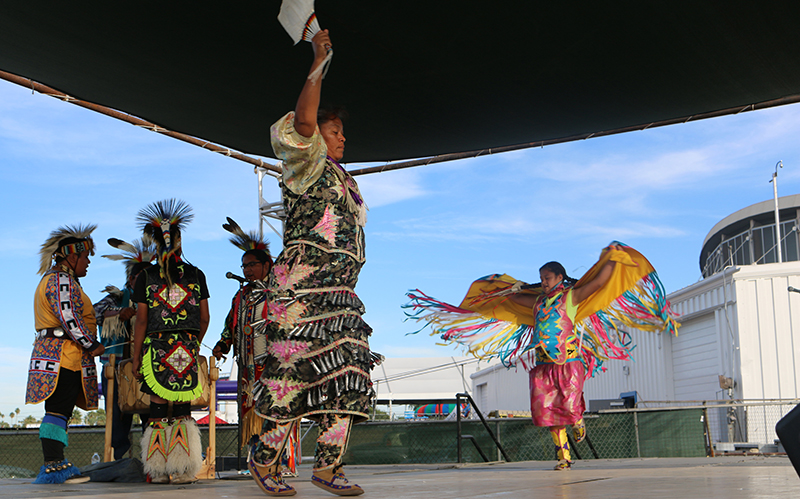
Palmer Lomakema plays a harmonious, Native American song on the wind flute at the Arizona State Fair. Photo by Kristiana Faddoul / Cronkite News
Native American group deflects stereotypes at Arizona State Fair
By Kristiana Faddoul
Cronkite News
cronkitenews.azpbs.org PHOENIX – Crispy corn dogs skewered on greasy sticks, Ferris wheels towering above the crowd, and toddler-sized teddy bears coveted as carnival-game prizes dominate Arizona State Fair culture. But one group is slipping in a glimpse of something more. Native Spirit members dance, chant and joke to debunk Native American stereotypes in several daily performances on a stage on the southwest corner of the fairgrounds. Native Spirit leverages comedy instead of lectures, defying caricatures and telling the audience the meanings behind each drum beat, dance step and musical note. The words didn’t have literal meanings but evoke feelings, such as lightheartedness, according to a group member. Palmer Lomakema, a be-feathered, longtime member of the group, joked on stage about movie and book stereotypes about Native Americans, such as scenes showing tribe members dancing around a fire all night before a battle. If that were the case, he told the audience gathered around the Cultural Stage, warriors would collapse at the first step they took on the battlefield. Giggles threaded through the crowd, which grew from a handful of people to about 80 as they wandered into a recent show.
Cronkite News: Native Spirit hoop dancing
Mesa resident Kenney Darville, who visited the fair with his family at another show, had never witnessed a Native American performance quite like Native Spirit. “I’ve never seen this type of dancing, this type of music; it was wonderful,”” Danville said. Still, the setting can be awkward. Phoenix resident Kyle Callon and his girlfriend, Briana Buchanan, who spent a Sunday evening at the fair jumping on the rides and sampling fair food, said they stopped for a minute but didn’t linger. “Would I expect to learn anything new from the state fair? No, because it’s not advertised to learn something new. It’s advertised for junk food and rides,” Callon said. “In the far off corners you see the Native Americans and the farms (presentation), it’s not really made for people to learn anything there,” he said. But there were plenty of people who stay. As his colleagues donned clothing for a performance, Lomakema said the fair provides a unique education platform.

Members of the Native Spirit dance group at the Arizona State Fair. Photo by Kristiana Faddoul / Cronkite News
In 2015, the total fair attendance came to about 1.2 million people, said Athena Sanchez, Arizona State Fair marketing specialist. “This is a great place because of the amount of people coming in,” Lomakema said. Native Spirit’s performances allow Native Americans to replace people’s false, stereotypical knowledge with accurate information, he said. “We give history about the dances, what they mean, where they actually come from and why we do these dances,” Lomakema said. The performers often share the background on their tribes, dismissing any presumptions Native Spirit members fall under one tribal community. “Native spirit is comprised of different nations,” Lomakema said. “We tell the people what tribes we come from, because everybody looks at us and thinks we are all the same.” Lomakema said Native Spirit members frequently receive positive feedback from those who attend the show. “I had two ladies come up and say, ‘You know, I’ve learned something new.’” Note: This article is published via a Creative Commons license. Cronkite News is produced by the Walter Cronkite School of Journalism and Mass Communication at Arizona State University.
Join the Conversation
